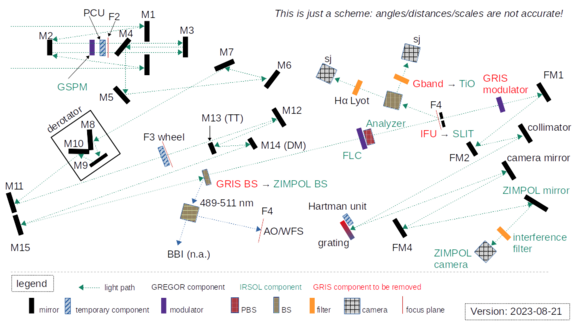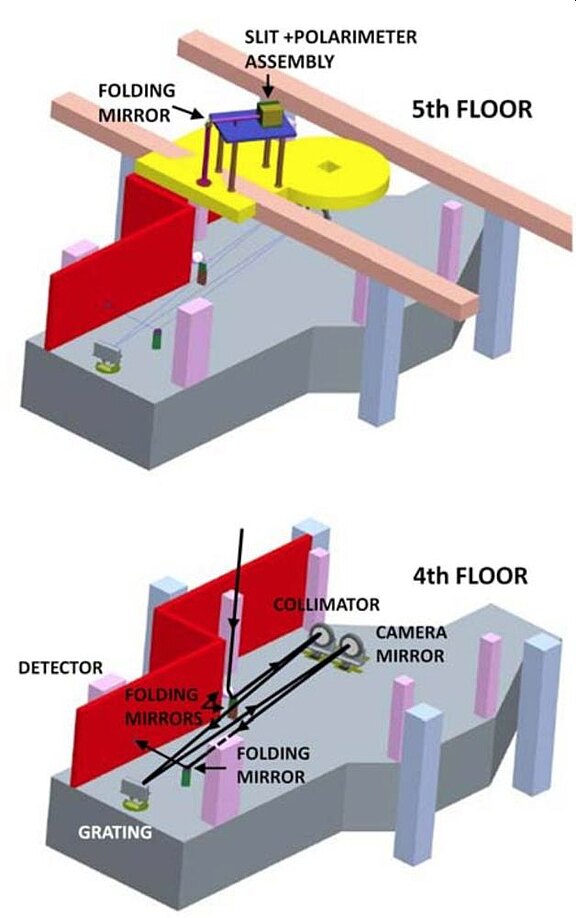Wavelength distribution at GREGOR
The image above shows the wavelength distribution and instruments at GREGOR foreseen for observations during the season 2022B. Two beamsplitters are located on a rotational stage. They transmit the IR and reflect the visible. The cutoff wavelength between transmission and reflection can be selected either as 900 nm or 650 nm. The IR beam goes towards GRIS. The visible beam goes towards the AO and the fast imaging cameras. When observing with the 900 nm beamsplitter, H-alpha is available for the fast cameras, but not in the slitjaw system and vice versa for the 650 nm beamsplitter. GRIS is available slit-scanner and in IFU mode in 2022B.
The wavelength range in the visible can be selected with interference filters. Regularly used filters are 430 nm (G-band), 450 nm (continuum), or 396 (Ca II K). The document vtt_filters_17.pdf contains a list of the available filters. See links on the right.
GRIS: spectropolarimetry in the near Infrared (slit or IFU)
GRIS (GREGOR Infrared Spectrograph) is the grating spectrograph installed at the GREGOR telescope. The spectrograph has a standard Czerny-Turner configuration with parabolic collimator and camera mirrors that belong to the same conic surface. Although nothing prevents its use at visible wavelengths, the spectrograph is mostly used in combination with the infrared detector of the Tenerife Infrared Polarimeter (TIP-II) in standard spectroscopic mode as well as for spectropolarimetric measurements. A slit scanner allows to scan some 60 arcsec, although scanning can also be performed with the AO. The slit length also corresponds to some 60 arcsec, with a sampling of 0.13 arcsec.
GRIS+TIP operates in the range 1.0–2.3 μm, however the polarimeter is optimized for 1–1.3 μm and 1.5–1.8 μm. The experience at the German Vacuum Tower Telescope (VTT), located at the same observatory, demonstrated that the most used spectral regions are those at 1.083μm (including the photospheric Si I and the chromospheric triplet He I) and at 1.565μm (with a number of iron lines including a line with g=3). As an example for the 1.565μm region: Five accumulations of 30ms exposure time each in the 4 polarimetric states yields a signal-to-noise ratio of 1000. In this case one scan step takes 3 sec. The instrument paper can be found here.
Starting in 2018B, GRIS is available in combination with the IFU built by the IAC. For a field of view (FOV) of 3" x 6" spatial and spectral information is then obtained simultaneously. The IFU is especially suitable for fast-cadence studies of a smaller FOV (e.g. evolution of granules), but it can also be used to scan across larger regions. The technical details can be found here. Changing the setup from slit-mode to IFU-mode requires maintenance time, and therefore the setup changes are minimized and usually only done between the two observing seasons.
Examples of GRIS scans from previous years can be viewed at the GRIS data archive.
GRIS is operated by the IAC. Manolo Collados is the Principal Investigator of GRIS.
BBI: broadband context imaging
The broadband imager consists of 2 sCMOS cameras, which are usually run at 30 Hz. Context imaging is useful to study the fast evolution of the Sun. BBI is usually run at the wavelength of G-band, TiO, or any two different filters can be selected for the 2 beams.The FOV is 59arcsec x 50arcsec, the resoultion 0.023arcsec/pix.
The observers are responsible for their own setup, including selecting filters. For further technical questions please contact Thomas Berkefeld. BBI is not available for 2024B.
PI Institute: Institute for Solar Physics
High-resolution Fast Imager (HiFI+)
The upgraded High-resolution Fast Imager (HiFI+) consists of three camera control computers with two synchronised sCMOS (16-bit digitisation) or CMOS (12-bit digitisation) cameras each. HiFI+ offers near-diffraction limited imaging at high cadence in six spectral windows:
– HiFI+ No. 1: G-band at 430.7 nm and blue continuum at 450.6 nm, Imager sCMOS, FOV: 70.7″ × 59.6″ (2560 × 2160 pixel), 20-second cadence, image selection (best 100 out of 500 images), speckle masking image restoration or Multi-Object Multi-Frame Blind Deconvolution (MOMFBD)
– HiFI+ No. 2: Narrow-band (FWHM = 60 pm) and broad-band (FWHM = 0.75 nm) Hα at 656.3 nm, Imager M-lite 2M, FOV: FOV: 76.5″ × 60.5″ (1536 × 1216 pixel), 6-second cadence, image selection (best 50 out of 500 images), MOMFBD
– HiFI+ No. 3: Ca II H at 396.8 nm and TiO at 705.7 nm, Imager M-lite 2M, FOV: 48.2″ × 30.8″ (1536 × 1216 pixel) and 76.5″ × 60.5″ (1536 × 1216 pixel), 6-second cadence, image selection (best 100 out of 500 images), speckle masking image restoration
Please contact the instrument PI for an introduction of HiFI+, training with the data acquisition, and installation of the data reduction pipeline. A data reduction pipeline for Level 1 data is available on site, and the PIs of observing campaigns are expected to reduce their data for archiving (https://gregor.aip.de). The data pipeline also provides provisions for image restoration. However, only a very limited number of images can be restored on site.
Denker, C., Kuckein, C., Verma, M., González Manrique, S.J., Diercke, A., Enke, H., Klar, J., Balthasar, H., Louis, R.E., Dineva, E. 2018:High-cadence Imaging and Imaging Spectroscopy at the GREGOR Solar Telescope—A Collaborative Research Environment for High-resolution Solar Physics. The Astrophysical Journal Supplement Series 236, 5, DOI: 10.3847/1538-4365/aab773
Denker, C., Dineva, E., Balthasar, H., Verma, M., Kuckein, C., Diercke, A., González Manrique, S.J. 2018:Image Quality in High-resolution and High-cadence Solar Imaging. Solar Physics 293, 44, DOI: 10.1007/s11207-018-1261-1
Kuckein, C., Denker, C., Verma, M., Balthasar, H., González Manrique, S.J., Louis, R E., Diercke, A. 2017:sTools—A Data Reduction Pipeline for the GREGOR Fabry-Pérot Interferometer and the High-resolution Fast Imager at the GREGOR Solar Telescope. IAU Symposium 327, 20, DOI: 10.1017/S1743921317000114
Denker, C., Verma, M., Wiśniewska, A., Kamlah, R., Kontogiannis, I., Dineva, E., Rendtel, J., Bauer, S.-V., Dionies, M. Önel, H., Woche, M. Kuckein, C., Seelemann, T., Pal, P. 2023: Improved High-resolution Fast Imager. Journal of Astronomical Telescopes, Instruments, and Systems 9(1) 015001, DOI: 10.1117/1.JATIS.9.1.015001
PI Institute: Leibniz Institute for Astrophysics Potsdam (AIP)
Instrument PI: apl. Prof. Dr. Carsten Denker (cdenker@~@aip.de)
Instrument Webpage: gregor.aip.de/cms/instruments/
ZIMPOL

In collaboration with IRSOL, high-precision spectropolarimetric observations with the ZIMPOL polarimeter are offered in service mode for projects requiring a short observing time (up to a few hours). Observations are carried out in combination with the GREGOR spectrograph, two slit-jaw cameras and standard AO. The use of the new off-limb AO is in the testing phase. The slit scanner is available (no IFU). In combination with the GREGOR Slow Polarization Modulator (GSPM), the ZIMPOL setup is particularly well suited for measuring polarimetric signals with the precision and accuracy down to 0.001 %, such as produced in the quiet photosphere near the solar limb by scattering and modified by the Hanle effect.
Applications by Interested researchers should specify the target, spectral region, minimal required polarimetric precision and scientific goal.
Data policy: the observing team members will carry out observations and provide reduced science-ready ZIMPOL data as well as data visualization tools. They are expected to appear as co-authors on papers with ZIMPOL data.
Contact: Renzo Ramelli, renzo.ramelli@~@irsol.usi.ch
Some technical data:
Available spectral range: 4250 Å - 6800 Å
Spectral window: few Angstroms (depending on order and wavelength)
Polarimetric precision: ~10-5
Pixel scale: 0.32 arcsec/pixel
Total area covered by ZIMPOL camera: 43.6 (±0.4) arcsec.
Slit width: 0.26 (±0.02) arcsec (70 µm)
References:
Ramelli, R., Gisler, D., Bianda, M., Bello González, N., Berdyugina, S., Soltau, D. 2014, "First successful deployment of the ZIMPOL-3 system at the GREGOR telescope," Proc. SPIE 9147, Ground-based and Airborne Instrumentation for Astronomy V, 91473G (8 July 2014); https://doi.org/10.1117/12.2056934
Ramelli, R., Balemi, S., Bianda, M., Defilippis, I., Gamma, L., Hagenbuch, S., Rogantini, M., Steiner, P., Stenflo, J. O. 2010, "ZIMPOL-3: a powerful solar polarimeter," Proc. SPIE 7735, Ground-based and Airborne Instrumentation for Astronomy III, 77351Y (15 July 2010); https://doi.org/10.1117/12.857120
Dhara, S.K., Capozzi, E., Gisler, D., Bianda, M., Ramelli, R., Berdyugina, S., Alsina, E.; Belluzzi, L. 2019, “Observations on spatial variations of the Sr I 4607 Å scattering polarization signals at different limb distances with ZIMPOL”, Astronomy and Astrophysics, vol. 630, pp. A67, 2019. doi:10.1051/0004-6361/201935768
![[Translate to English:] Option 1](/fileadmin/images/science/solar_telescopes/gregor/gregor_opmode2021b_opt1.jpg)
![[Translate to English:] Option 2](/fileadmin/images/science/solar_telescopes/gregor/gregor_opmode2021b_opt2.jpg)
